General requirements for waterproofing
Foundation waterproofing
When to do foundation waterproofing
Slab foundation waterproofing
Waterproofing strip foundation
Waterproofing of pillar and pile foundations
Basement waterproofing
Basement waterproofing
What materials should not be used to waterproof the foundation and basement
General requirements for waterproofing.
We often do not attach due importance to waterproofing and after a while we observe the results of the destructive effect of water on the structure of the house.
Non-waterproof basement
It is much easier to prevent these consequences. To do this, it is important to protect such structures from moisture:
house walls
floors on the ground
nodes of adjoining door and window openings.
foundation
basement floor and walls
If you pay attention, almost all house structures are listed here, except, probably, internal partitions.
So, how to make the correct waterproofing of the foundation, basement and other structures? The waterproofing layer of any structure must be continuous and without breaks over the entire insulated surface. A waterproofing layer is installed on the side of the structure on which the hydrostatic head acts, or there is a threat of capillary rise and water seepage.
Foundation waterproofing.
When do you need to waterproof your foundation?
Any foundation should be protected from two types of water: surface (precipitation) and groundwater (groundwater).
The blind area protects from penetration and negative impact on the foundation of surface water. And this is its main function. You can read more about the blind area in the article: Blind area. The device of the blind area at home. And if there is surface water in any area and blind area, thus, should be done always and by everyone, without exception, then groundwater and, accordingly, waterproofing from them is not always needed. To say that there is no groundwater in any area and there is no need to waterproof the foundation would be wrong. Indeed, in our area, underground waters are almost everywhere. The question is the depth of their occurrence relative to the basement level, as well as the level of seasonal uplift groundwater during the spring flood.
1. Waterproofing of the foundation must be done if the ground water level (GWL) is located at a depth of less than 1 meter from the bottom of the foundation. This value is indicated taking into account the spring rise of the groundwater level, since it often happens that the groundwater level located at the same depth in summer, in spring due to snow melting, rises 1 - 2 meters higher. With such an arrangement of the groundwater level, waterproofing will protect the foundation from capillary rise of groundwater and for this purpose, a coating waterproofing will be sufficient.
2. If the groundwater level lies at a depth of more than 1 m from the bottom of the foundation, then waterproofing, in principle, can not be done. But I would like to draw your attention to the fact that the GWL tends to increase not only seasonally - in spring, but also over time (over the years) due to an increase in building density, due to the arrangement of drainages in neighboring areas, asphalting of adjacent territories, as well as when creating non-waterproof artificial reservoirs at a distance of even 1 km. Such changes are usually called long-term GWL fluctuations. Considering them, even with a low GWL, it is advisable to make at least the most inexpensive waterproofing of the foundation - coating, especially in the presence of a basement.
3. If the groundwater level is high - above the bottom of the foundation, then in addition to waterproofing, drainage must also be done to drain water from the foundation.
 Groundwater level above the level of the bottom of the foundation
Groundwater level above the level of the bottom of the foundation
Why can't you do just waterproofing? When water is above the level of the foot of the foundation, it creates hydrostatic pressure on the foundation, which reduces the force of the foundation pressure against the foundation. Those. in simple words, the supporting force of the foundation decreases, as a result of which the foundation may shift and even overturn if left unloaded on such soils, for example, for the winter. Therefore, the foundation needs not only to be protected from excess moisture, but also to lower the GWL. And drainage makes it possible to lower the groundwater level and thereby reduce the hydrostatic pressure on the foundation, which waterproofing does not provide.
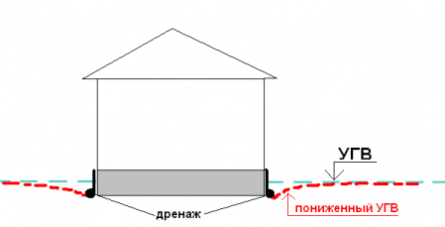 Lowering GWL
Lowering GWL
4. Sometimes, serious waterproofing of the foundation should be done independently of the groundwater level. There is a need for this if the construction of a house is planned on waterproof or so-called waterproof soils (clay, loam) with layers of permeable soil. Because such soils do not allow surface water to easily leave permeable areas into the lower layers of the soil, and the water moves along the path of least resistance, namely, to the foundation. Therefore, it must be waterproofed.
 Construction on waterproof soil
Construction on waterproof soil
Water resistant soils are considered to have a filtration coefficient k<10 -6 cm / s. Filtration coefficient, k, cm / s (accepted characteristic of soil water permeability) has the following values \u200b\u200bfor different soils:
sands10 -2 -10 -4
sandy loam and loam10 -3 -10 -8
clay10 -7 -10 -10 .
5. Regardless of the groundwater level and the type of foundation, it is very important to pay attention to the composition of groundwater (GW), which is shown by engineering and geological surveys. In some areas, aggressive HSs are found. They negatively affect the bearing capacity of concrete, simply destroying it, which is commonly called concrete corrosion.
 Concrete corrosion
Concrete corrosion
Therefore, to protect such foundations, it is recommended to construct them from moisture-resistant concrete of grade W4 or higher (according to clause 2.9. SNiP 2.03.11-85). And all waterproofing materials used for such foundations must be resistant to aggressive environments. The most dangerous for concrete and mortars are pressurized aggressive groundwater.
Further we will analyze the types of waterproofing for different foundations. You can choose the right waterproofing if you know the type of foundation, and how "pressure head" groundwater is, so a few words about it. All groundwater is conventionally divided into suspended, non-pressure, low-pressure, and pressure.
Unconfined groundwater- are in direct contact with the atmosphere through the open pores of the permeable medium.
Pressure water separated from the atmosphere by relatively impermeable rocks, they have sufficient pressure to pour themselves onto the surface of the earth.
Low-pressure water are in transitional conditions typical for both pressure and non-pressure waters.
Suspended waters- the first unconfined waters from the earth's surface are located above the main zone of unconfined waters and represent more or less isolated accumulations of water.
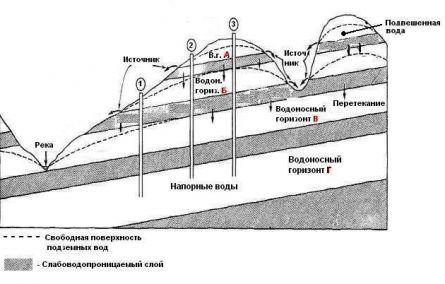 An example of the occurrence of aquifers
An example of the occurrence of aquifers
Figure shows the typical occurrence of aquifers represented by sedimentary rocks. (Rice Pressurized, non-pressurized aggressive waters). In the position when well 1 is laid, the water of horizon B is considered suspended, and the water of horizon C is free-flow. Well 2 passes through the suspended water of horizon A, unconfined water of horizon B and confined water of horizons C and D. Well 3 penetrates confined waters in all horizons, except for horizon A.
Thus, in a small area with a simple geological structure within one aquifer, water can be suspended, free-flowing and pressure-bearing
Wherever the groundwater level is located, the base of any foundation must be laid with a layer of permeable material, for example sand + crushed stone.
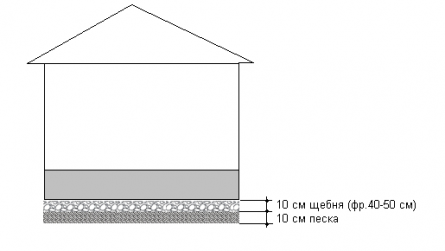 Crushed stone cushion from capillary rise of hot water
Crushed stone cushion from capillary rise of hot water
Such a cushion interrupts the capillary rise of groundwater.
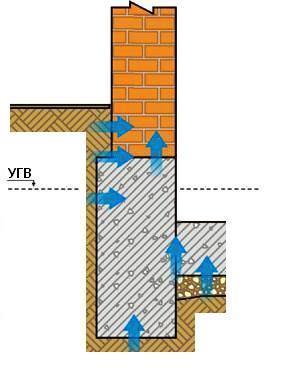 Capillary rise of hot water
Capillary rise of hot water
Below we will consider how to make waterproofing of the foundation of various types and the features inherent in each type.
Slab foundation waterproofing.
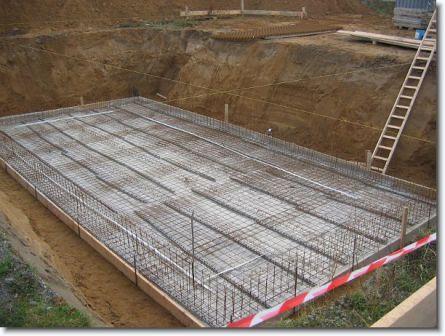 Slab foundation
Slab foundation
It is recommended to waterproof the slab foundation with rolled roofing material. The waterproofing layer is placed on the foundation slab. If its surface is uneven, then a leveling screed is first made. Insulation is laid on top of the waterproofing, a screed is made over it, and a floor covering is already placed on the screed.
Waterproofing strip foundation.
The strip foundation can be waterproofed in various ways.
1. Covering with bitumen mastic.
 Coating with bituminous mastic
Coating with bituminous mastic
The most economical option. Suitable in such cases: protection of the foundation from possible capillary rise of groundwater level, protection of the foundation from possible penetration of surface water. The coating waterproofing does not protect against pressure water, since it cannot withstand a set of more than 2 meters. This waterproofing is most often and most easily damaged, and therefore most often it leaks, since it does not tolerate shear and tensile loads. Therefore, such waterproofing must be applied on a flat surface, which must be pre-dried, round the corners of the house, and also protect the waterproofing from mechanical damage. Such waterproofing is usually damaged when filling the pit with backfill soil, which often contains construction debris (stones, fragments of reinforcement, glass, etc. debris).
You can protect:
ePS insulation (considering that the foundation should be insulated to the level of soil freezing);
 EPPS waterproofing protection
EPPS waterproofing protection
roll geotextile, can be needle-punched, it is cheaper than thermally bonded, the required density is at least 180 g / sq. m;
a pressure wall made of brick, this is sometimes done, but the option is quite laborious and expensive, therefore it is inferior to the two above-described options for protecting waterproofing;
if the backfill of the pit is done with soft soil without debris, for example sand, then it is enough to protect the waterproofing only at the corners of the house, with geotextile strips 20 cm wide.
2. Waterproofing with roll material.
 Waterproofing roll material
Waterproofing roll material
Roofing material is most often used from roll materials. This is a slightly more expensive option than a waterproofing seal, but more durable and durable. If the backfill soil does not contain debris, then such waterproofing may not be protected. The foundation surface must be flat. The foundation is processed with hot bitumen mastic, on which at least 2 layers of roofing material are glued with an overlap of 10-20 cm.
3. Sprayed waterproofing.
 Sprayed waterproofing
Sprayed waterproofing
Very easy and quick to apply with a special spray gun. Easily repeats all the unevenness of the foundation, does not need special surface preparation, except for cleaning from dust. More expensive material than conventional bitumen mastic. Requires mandatory reinforcement with thermally bonded geotextile material with a density of at least 130 g / sq. m, which simultaneously performs a protective function for this waterproofing. The material is quite expensive and it is economically profitable to use it for foundations of complex shapes (which are difficult to glue with roll material) or for a foundation laid very close to another building (that is, if such a foundation is very inconvenient to waterproof due to the lack of free access to it).
In addition to the methods described, you can perform waterproofing by applying 25-30 mm of cement mortar with a water pressure of up to 20 m.
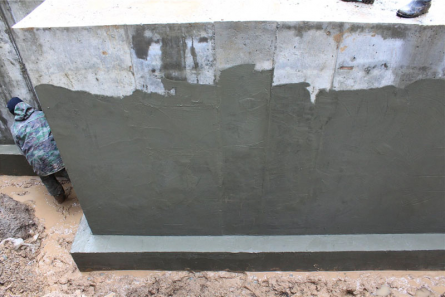 Waterproofing with cement mortar
Waterproofing with cement mortar
It is also possible to waterproof the foundation with various waterproofing materials of a penetrating effect (a mixture of cement, quartz sand and active additives), which protects the foundation from excess moisture and some chemical compounds (depending on the brand of waterproofing), but this material is quite expensive.
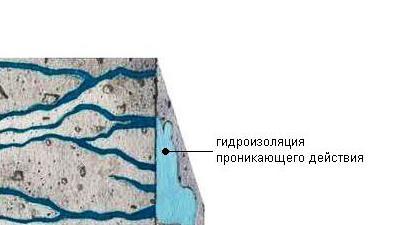 Penetrating waterproofing
Penetrating waterproofing
Foundation waterproofing for foundation pit with 90 ° walls.
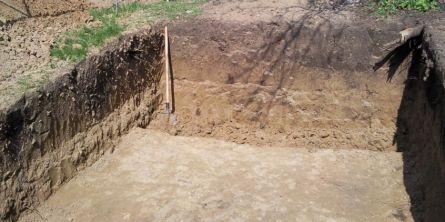 Pit with a slope angle of the walls of 90 degrees.
Pit with a slope angle of the walls of 90 degrees.
Sometimes the foundation is erected close to the walls of the pit, this is the only possible option in the cramped construction conditions. In this case, the pit is erected with walls at an angle of 90 °, pressure walls are erected close to the walls of the pit, and nailed to them waterproofing material (or first drainage, and then waterproofing, depending on the groundwater level). The formwork is installed at a distance from the pressure wall equal to the width of the future foundation. And in the resulting formwork (on the one hand, the pressure wall with waterproofing, on the other, the formwork is simply laid with the reinforcement connected in advance and the foundation is poured. The pressure wall with waterproofing in this case is called "lost formwork", since it is not removed, but remains in the ground If, in cramped conditions, a foundation is erected from blocks, then the blocks are placed at a short distance from the pressure wall and the resulting distance between the block foundation and the waterproofed pressure wall is filled with mortar.
Protection of walls against moisture capillary rise.
 Capillary rise of moisture
Capillary rise of moisture
Anti-capillary waterproofing in the walls is laid on a plinth, which usually ends at a level of 15 -50 cm above the ground level. The surface of the basement is pre-leveled, dried and covered with a layer of bituminous mastic. Then 2 layers of roofing material are laid. This waterproofing is called a continuous strip and must completely cross the entire thickness of the wall and the internal plaster.
 Protection of walls against moisture capillary rise
Protection of walls against moisture capillary rise
Waterproofing of pillar and pile foundations.
Pile foundations are waterproofed using a grillage.
It is extremely difficult to waterproof piles and pillars, it will take a lot of time and effort in the case of pillars and almost impossible in the case of piles. Therefore, such pillars or piles are recommended to be made of moisture-resistant concrete of grade W4 and higher for non-aggressive hot water and from grade W6 and higher for aggressive ones.
The foundation made of wooden piles must be treated with an anti-corrosion solution.
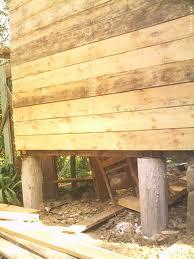 Wooden pile foundation
Wooden pile foundation
At the same time, it is important to remember that it is not advisable to take measures to lower the GWL, i.e. do any drainage, since wooden piles do not rot only when they are completely in the water. Otherwise, there is a great risk of reducing their service life.
Basement waterproofing.
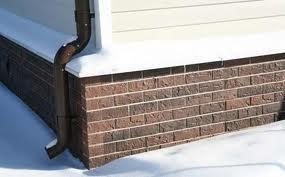 Basement waterproofing
Basement waterproofing
The plinth from the outside up to the level of the continuous gasket (10 -50 cm from the ground level) must be waterproofed in order to protect the wall of the house from surface water. The fact is that the average height of the snow cover is usually 10-50 cm, and raindrops fighting off from the blind area most of all soak 10-50 cm from the ground level. That is why the plinth must be covered with a waterproof material, for example, water-repellent tiles.
Basement waterproofing.
For a house with a basement, a waterproof blind area is required, which will reduce the flow of surface water to the walls of the basement.
The basement floor is waterproofed using concrete preparation. Waterproofing from 2 layers of rolled bitumen material is very suitable for these purposes.
The basement walls are waterproofed according to the same principle as the strip foundation, which was described above. Also for waterproofing a basement, waterproofing from bentonite mats is very effective.
 Bentonite mats
Bentonite mats
It is a modern compact analogue of the classic clay castle. The material is bentonite enclosed in textile material on both sides. Easy to install, while replacing 1 meter of clay (classic clay castle).
If the groundwater at the site is pressurized, and it is necessary to drain around the perimeter of the basement, it is very important to remember that drainage begins to work only from the moment the water from the drainage material (entering further into the drainage pipes at the base of the foundation) begins to be discharged, for example, into the storm sewer ... Up to this point, there may even be water in the pit, despite the fact that all the drainage materials have already been laid.
I want to draw your attention - do not regret the basement waterproofing and do it very carefully. And if you hire builders for this work, then carefully control this stage. Because this is the kind of work that is difficult to fix when leaks already appear. Indeed, to repair the waterproofing of the basement, you have to re-open the foundation pit. And by this time, there is often a blind area and the adjacent territories are partially inhabited. Therefore, basement waterproofing should be taken seriously.
If it so happened that for some reason the basement began to leak, then the best option would be to re-open the foundation pit and replace the completely or partially damaged waterproofing. If there is no opportunity to open the pit, for example, due to the density of the building, then waterproofing can be done from the inside of the basement. But in this case, the walls will unfortunately continue to get wet, despite the fact that from the inside of the basement they will look dry.
What materials should not be used to waterproof the foundation and basement.
The foundation and basement cannot be waterproofed with roofing films (waterproofing, vapor barrier) and membranes, including windproof ones. These materials are too thin and are designed for loose laying with sagging (they cannot even be pulled). In addition, films and membranes will not withstand friction against the surface of the foundation due to constant seasonal movements of the soil, not to mention the fact that they are not designed for protection from pressurized groundwater. Therefore, their use for waterproofing foundations and basements is impractical.
It is not economically feasible to use UV-stabilized materials for these purposes, for example, UV-stabilized PVC membrane. Since UV-resistant materials are more expensive, this function will simply not be used underground.
The utility model relates to construction and can be used to prevent moisture penetration in the basements of buildings, basements and other underground structures such as subways, tunnels, cellars. EFFECT: provides an effective solution to prevent moisture penetration through the walls of buildings and other underground structures without the use of energy-consuming equipment and the need for waterproofing; the acceleration and reduction in the cost of the construction of waterproofing protection is provided. The claimed technical result is achieved due to the fact that the device for waterproofing the walls of basements, basements and other underground structures, consisting of a clamping brick wall, characterized in that as a clamping brick wall, masonry of raw brick (adobe brick) of plastic molding, protected from drying to the moment of installation.
Application area
The utility model relates to construction and can be used to prevent moisture penetration in the basements of buildings, basements and other underground structures such as subways, tunnels, cellars.
State of the art
Currently, there is a need in buildings to provide a stable microclimate in basements, basements of buildings and other underground structures so that moisture does not accumulate in them, which contributes to the reproduction of mosquitoes and moldy walls.
At the present stage, with a large accumulation of liquid in the basements, it is pumped out by pumps.
However, with small insignificant accumulations of liquid in the basements, as a rule, nothing is done to eliminate it.
Water enters the basement through the pores in the walls during floods and rains, when the groundwater stands close.
To ensure that even small amounts of moisture do not accumulate in basements, it is necessary to ventilate (dry) the basements.
According to SNiP 31-02-2001, during the construction of houses in areas where, according to engineering and environmental surveys, there are emissions of soil gases (radon, methane, etc.), measures should be taken to isolate the floors and walls of basements in contact with the ground in order to prevent the penetration of soil gas from the ground into the house, and other measures to reduce its concentration in accordance with the requirements of sanitary standards. To prevent the ingress of soil gases, the concrete slab of the basement floor must hermetically adhere to the wall along the perimeter of the basement, and the junction area must be covered with sealant, that is, the concrete slab acts as an “air barrier” that prevents the penetration of soil gases. However, attempts to solve this problem by sealing cracks and other holes in the basement are not always effective, therefore, systems for removing such gases are provided in the basement - a ventilation duct is installed through which the basement is connected to the atmosphere. To prevent the entry of soil gases, the gravel drainage layer under the concrete slab of the basement floor must also communicate with the atmosphere. Thus, the arrangement of basement ventilation in apartment buildings sometimes becomes a necessity not only because of plans to use the basement area, but also purely because of considerations of compliance with sanitary standards in the operation of buildings.
However, the ventilation device is expensive, it is not always possible, and in addition, with constant penetration of moisture, it requires continuous operation, and in the event of a breakdown, the basement will quickly become damp.
Moisture from other underground structures such as tunnels, passages and cellars is not pumped out at all, except occasionally with mobile pumping units, with large volumes of accumulated moisture.
At the same time, underground structures are quickly destroyed.
To eliminate these problems in buildings and underground structures, waterproofing is used, with a clamping brick wall.
A typical architectural detail of an external waterproofing device with a clamping brick wall, usually made in half a brick, serves to protect the waterproofing from mechanical damage.
The disadvantage of this typical technology is that it is expensive and ineffective, since the pressure wall acts as a drain, allowing moisture to pass into the internal cavity in the area between the wall and the waterproofing layer. A hydrostatic backwater forms in the cavity, which finds holes in the waterproofing and damages it.
Moisture penetrates through the pressure wall, no matter how layers of bitumen are coated on the outside of the pressure wall. This is due to annual temperature changes that form cracks in the layer of the pressure wall coating, through which moisture penetrates.
EFFECT: provides an effective solution to prevent moisture penetration through the walls of buildings and other underground structures without the use of energy-consuming equipment and the need for waterproofing; the acceleration and reduction in the cost of the construction of waterproofing protection is provided.
Implementation of the utility model
The claimed technical result is achieved due to the fact that the device for waterproofing the walls of basements, basements and other underground structures, consisting of a clamping brick wall, characterized in that as a clamping brick wall, masonry of raw brick (adobe brick) of plastic molding, protected from drying to the moment of installation. The masonry is made in half-brick (120 mm thick).
Brief Description of Drawings
Figure 1 shows the constructive device of the utility model, where 1 is the internal space of a building or underground structure, 2 is a foundation slab or floor of a building or structure, 3 is a protective brickwork made of raw bricks, 4 is the inner walls of a building or an underground structure, 5 is accumulated soil moisture - 6.
Implementation of the utility model
When erecting a basement or basement of a building (see Fig. 1) or an underground structure after installation on the foundation slab (2) of the outer walls (4) of the building, the outer walls along the perimeter of all the walls of the building adjacent to the ground and the walls of the underground structure are laid with masonry from raw brick (3) - adobe bricks from pure raw clay.
Raw bricks are obtained at a brick factory without the use of burnt-out additives and stored until delivery to the construction site (before the start of laying the wall) in the same form as it is obtained during manufacture. Protection of the raw brick from drying out is necessary with a view to the fact that after drying, the raw brick cracks, becomes swollen, loses its shape and is not suitable for laying.
The masonry is performed as follows. The raw brick is quickly dipped in a bucket of water and just as quickly planted in the solution. The brick absorbs moisture almost instantly, and if you delay, it will go inside and the adhesion between the raw and clay mortar may not occur.
Seal and trim the masonry with a wooden or rubber mallet.
It is preferable to lay the masonry in half a brick (120 mm). It is not advisable to do more in order to save internal space, and it is impossible to do less masonry, since the laid out wall may fall off (unstable).
When the bricks are completely laid in the masonry, and the mortar has dried up, carefully examine the relief and remove all kinds of irregularities and sagging with a greasy scraper, knife or chisel. Individual roughness is removed with abrasive paper of various grain sizes. The flat surfaces of the masonry are rubbed without water with a burnt red brick float. All kinds of cracks and dents found after lapping are immediately sealed with clay mortar. The cracks are pre-cut with the tip of a knife so that grooves about 4-5 mm wide are formed in their place. The grooves are abundantly moistened with water using a sponge or a bristle brush and covered with a clay solution so that small bumps rise in the place of the former cracks. After drying, the clay "shrinks" and the bumps disappear.
The principle of operation of the utility model is as follows.
When moisture penetrates the masonry (3) made of raw brick, it is absorbed by it until the masonry clay is completely saturated with water. At the moment of complete saturation with water, the brickwork (3) of raw brick ceases to pass moisture through itself onto the inner walls (4) and ceases to absorb moisture.
Liquefying, the masonry (3) begins to expand and self-eliminates all the pores and cracks of its walls, as well as cracks and pores of the inner walls (4) of the room.
Thus, even with a continuous supply of moisture, raw brick masonry will serve as an excellent barrier for its further penetration into the inner space (1) of basements and basements of buildings and underground structures, and at the same time does not require any energy consumption and the use of waterproofing.
In addition, since raw brick is much cheaper to manufacture and faster to manufacture than fired brick, the process of building a waterproofing structure becomes cheaper and faster. Acceleration and cheaper construction of a waterproofing structure is also ensured by eliminating the need to use cement in the construction of masonry.
Sources of information:
1.http: //www.rubliovka.ru/isk/iskpir.htm
2.http: //novostrojka.ru/content/view/1557/28/
3.http: //www.kamenschik.com/kinds-waterproofing-appointment.html
1. A device for waterproofing basement walls, basements and other underground structures, consisting of a clamping brick wall, characterized in that as a clamping brick wall, masonry of raw bricks (adobe bricks) of plastic molding is used, protected from drying out until the moment of laying.
2. Waterproofing device according to claim 1, characterized in that the masonry is made in half a brick (120 mm thick).
Ever since the building of communism in our country, it has become customary to arrange a basement in the garage. It is necessary in order to store food: vegetables and fruits grown in summer cottages. The residents of high-rise buildings simply have no other way to store the harvest grown with such difficulty. Basement construction is a very demanding business. If you do not follow the technology, you can create ideal conditions for the life of pathogenic flora. Despite the fact that for the successful and long-term storage of vegetables in the basement there must be a certain sufficiently high humidity, nevertheless, everything should be in moderation. If mold or other fungi have settled in the basement, then goodbye to the harvest. That is why basement waterproofing is the most important stage in its construction.
This article will tell you how to properly waterproof a basement during the construction phase. And the question of what to do if you become the proud owner of a garage with a basement without waterproofing will also be raised.
Basement waterproofing scheme if the water table is above the floor or basement walls
Basement waterproofing is divided into several types:
Anti-pressure waterproofing - basement waterproofing from groundwater, the level of which is above the level of the basement floor or even its walls. It is the application of a cake of at least 3 layers of slurry solutions, which are combined with mastics based on polymer bitumen.
Non-pressure waterproofing basement protects it from moisture that has accumulated after precipitation or floods. It consists in applying bituminous mastics to the floor surface.
Anti-capillary waterproofing protects against the penetration of moisture through the concrete floor or walls, which can rise up through the capillaries. In addition to anti-pressure waterproofing measures, seams, cracks and capillaries are insulated.
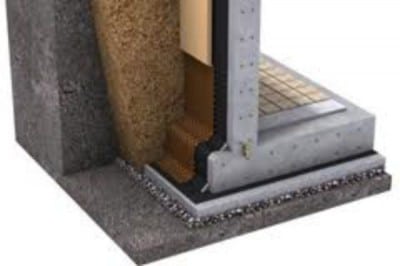
Basement floor waterproofing scheme
It is possible to insulate the floor qualitatively only during the construction phase. There are methods for insulating the floor already during the operation of the finished garage, but waterproofing from the inside will not be enough. Therefore, if you decide to build a basement in a garage or house, you need to perform the following work:
- We calculate the depth of the pit, which must be dug. To do this, we take into account the height of future ceilings in the basement, the height of the floors, the thickness of the concrete floor and the preparatory layer. Most often, the ceiling of the basement in the garage is buried below the level of freezing of the soil, approximately by 0.5-1 m.Thus, the depth of the pit should be 3.3-3.5 m.
- We are digging a pit not only to the required depth, we are retreating at least another 1 m from the future foundation and walls for arranging the waterproofing of the walls.
- We level the surface, making a slight slope from the middle in different directions. We fill in a 10 cm layer of clay and tamp it. In the future, it will serve us as a clay castle.
- Digging drainage trenches. Depth 30-50 cm. We give them slopes to the sides of the building.
- We spread geotextiles to the bottom of the trench, wrapping it by the edges of the trench by 80-90 cm.
- Fill in a 5 cm layer of gravel along the entire length of the trench.
- We lay the drainage pipes, making a slope of 0.5 cm per 1 linear meter.
- We fill in a 20-30 cm layer of gravel, which is better to rinse beforehand so that the pipes do not clog.
- We wrap it up with the remaining geotextile. We take out the drainage pipes either into a manhole, or into a drain collector, or into a pit.
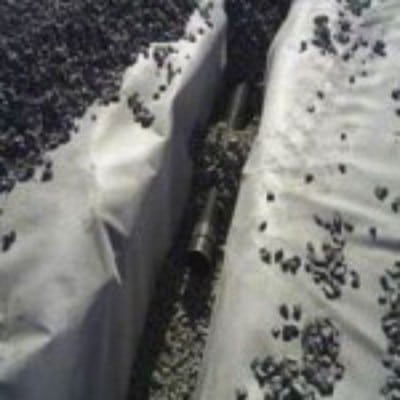
Drainage ditches are covered with gravel and wrapped with geotextiles
Important! Drainage is necessary in order to collect and drain the drained water to special places (wells). For it, you can use special perforated asbestos-cement pipes, ceramic or plastic.
10. In the pit we fill in a 10-15 cm layer of crushed stone, on top of 10-15 cm of sand. We tamp.
Important! The sand is necessary in order not to damage the roll waterproofing with the sharp edges of crushed stone.
11. On the prepared base, roll out any roll waterproofing. Roofing material will do. We weld the joints with a gas torch. We coat the first layer with bituminous mastic, lay the next layer. It is necessary to make at least 2 layers. If the groundwater level is above the basement floor, then there should be 3-4 layers.
Important! If the basement is made for storing food, then there is no need to insulate its floor. Coolness from the ground during the cold season will provide the required temperature. In this case, you will have to insulate the floor of the first floor.
12. Prepare the formwork for the floor and pour concrete.
Important! It is advisable to use waterproof rigid concrete mixes. It will not be superfluous to fill the walls with concrete, but red brick can also be used.
If you are interested in the question of how to make a basement waterproofing when it has already been built, then you will read the answer below. We'll only have to waterproof the walls outside and inside.
The outer wall of the basement will have to be dug to the depth of almost the entire basement and equip a clay castle and a blind area.
To keep water out of the walls
If you decide to build the walls of brick, then we carry out the usual masonry. If you decide to make it out of concrete, then we prepare the formwork for the walls and pour the concrete.
Important! Sand lime brick is not suitable for building a basement.
Further waterproofing the basement with your own hands looks like this:
- Plaster the walls on both sides with mortar: 1 part cement + 2 parts water.
- We glue roll waterproofing in two layers.
- We build a pressure wall outside. It can be made from red bricks into one brick.
Important! The pressure wall is necessary in order to support and protect the roll waterproofing layer.
4. We make a clay castle at a distance of at least 0.5 m from the wall. We make it with a slope, as shown in the figure. The clay layer should be 100 mm, we compact it with wooden blocks. This layer should match the clay layer under the floor so that it is one piece.
Important! The clay lock prevents groundwater from contacting the pressure wall.
5. Fill up the space between the clay castle and the wall with soil. From above we make a clay-crushed stone blind area. We make a slight slope from the walls so that the rainwater does not drain under the basement, but in the other direction.
6. The outer part of the wall protruding above the ground level is treated with a coating waterproofing.
On this, all the work on waterproofing the walls of the basement from the outside is completed, you can proceed to the internal work.
We isolate the built basement from the inside
First of all, we coat all joints between the floor and walls with bituminous mastic. It is advisable to pre-treat concrete structures (floor or floor and walls) with penetrating waterproofing in order to improve the effect. But this work must be carried out only while the concrete has not yet hardened to the end. If work is being carried out in an already finished basement, then the floor is only smeared with mastic.
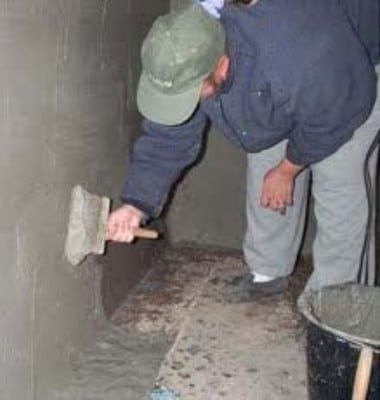
To waterproof the basement from the inside, we coat it with bituminous mastic and plaster it with a cement mixture
If the walls are made of bricks or blocks, between which there are gaps, we coat all the gaps with waterproofing mastic 2 cm thick.
It can then be treated with a light textured putty. The wall will take on a uniform color.
Plaster the wall with a cement mixture on top. To give rigidity, we fasten the reinforcement frame to the wall. Then we plaster with a layer of 3-4 cm.
For good preservation of products in the basement, its walls can be treated with biologically resistant coatings.
Bitumen can be taken of any brand, and cement is only waterproof. We melt the bitumen at a temperature of 1500-1700 ° C, add the remaining components according to the recipe, mix for 20 minutes and use it while it is hot.

Bio-resistant bitumen coatings
This completes the waterproofing of the basement from the inside with your own hands. Next, let's take a closer look at the materials for waterproofing.

Penetrating waterproofing blocks the rise of water through the capillaries
Penetrating waterproofing is a material made from a mixture of cement, active chemicals and fine sand. The substance penetrates into the walls and floor by 100 mm and crystallizes inside. This is due to the fluid structure and small grain size.
Important! Penetrating waterproofing is used as an anti-capillary insulation. Hydrophobic crystals form inside the concrete, preventing the rise of water through the capillaries.
In addition, the frost resistance of concrete increases and its corrosion is prevented. This technology has an antibacterial composition, non-toxic, which makes it possible to use it in cellars with food.
The penetrating waterproofing differs in the method of application and the depth of penetration.
For example, "Hydrotex" penetrates up to 100 mm, applied with a spatula, or with a brush. Consumption: 3 kg / m 2. The maximum strength of 3 mm corresponds to the M 500 grade. It has a double effect.
"Penetron" penetrates up to 200 mm, is applied with a brush on a damp surface, layer up to 1-2 mm. Water acts as a solvent. Closes capillaries, preventing water penetration, but does not impede steam movement.
Important! Penetrating waterproofing is used only on wet concrete. The material processed by it is able to withstand any pressure of groundwater, its resource increases significantly.
Painting waterproofing, types
If the groundwater level is below the basement floor, bitumen, bitumen-polymer, polymer and polymer-cement mixtures can be used as waterproofing.
Bituminous mastics, pastes and emulsions are applied in several layers with a thickness of 2-6 mm.
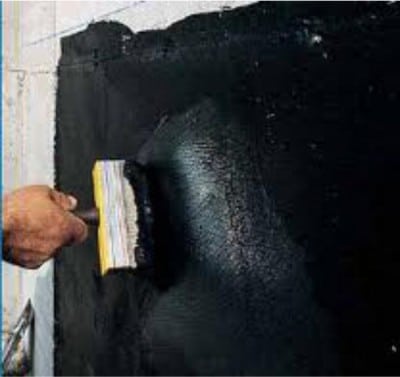
Bituminous mastics are used as paint waterproofing
Bitumen-polymer paint waterproofing better simply bituminous in terms of performance by adding polymers such as latex to the composition. The required layer ranges from 5 to 12 mm, depending on the composition.
Bituminous-nairite mastic (BNM) can be used at temperatures up to -15 ° C, it is enough to apply a layer of 3-4 mm.
Epoxy coatings low plasticity and shrinkage due to too pure resins in the composition.
Epoxy-tar waterproofing stronger, has minimal shrinkage and does not freeze with the outer ice when the building freezes.
Epoxy-furan waterproofing more toxic, although it requires a smaller layer.
Important! Epoxy-based waterproofing can be done both outside the basement and inside. Its significant drawback is too high rigidity.
Oleechnaya waterproofing roofing material, roofing felt or other roll materials is the most popular and has held positions for many decades.
Video: comprehensive waterproofing
There are many waterproofing products and materials on the market. When choosing them, you should pay attention to their characteristics and operating conditions. But the most important thing is to perform high-quality waterproofing of the basement at all stages.
Any construction material has a porous structure, therefore, a violation of the waterproofing of the structure leads to the fact that the floor, walls, decoration Materials buildings turn into a sponge that constantly absorbs moisture from the soil. High-quality waterproofing of the foundation can prevent damage and gradual destruction of the house. The quality of work affects the durability of the structure, maintaining the required microclimate, the absence of mold and mildew. But before proceeding with the waterproofing work, even at the stage of preparation for construction, it is necessary to decide on the right choice materials and method of its device. In this case, the type of foundation should be taken into account, as well as the features of the work and materials required to protect it. Works on waterproofing SNiP 2.02.01-83 are regulated.
Monolithic slab foundation
Waterproofed with rolled roofing felt, laid directly on foundation slabs... In case of irregularities on the surface, a heater is placed, which is also covered with a screed, on which the floor covering is mounted.
Slab foundations completely covered with waterproofing material
Strip foundations
There are several processing methods that are suitable in cases where you are interested in DIY foundation waterproofing. Strip foundations are the easiest to handle.
Coating with bituminous mastic
The most economical of the options. Suitable for protecting the foundation from surface water, protects it from capillary rise. But coating insulation will not save you from pressure water. It does not tolerate either tensile or shear loads. Also, such waterproofing is easier and most often damaged and leaks. Therefore, the mastic should be applied to a flat and pre-dried surface. The corners of the house should be rounded and the surface of the insulation protected from mechanical damage. Damage can already be caused during backfilling of the excavation with soil, which often contains construction waste.
You can protect the mastic:
- rolled geotextiles, either thermally bonded or needle-punched (cheaper);
- ePS insulation (insulating the foundation at the level of soil freezing);
- a clamping brick wall, however, this is an expensive and time-consuming option;
- if the backfill is done with soft, debris-free soil, it is enough to protect the corners with geotextiles 20 cm wide.
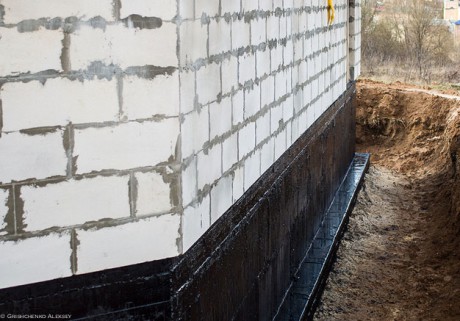
The coating technology is the simplest, but the most unreliable
Roll materials
Roofing material is the material that is most often used for such purposes. This option is not much more expensive than the previous one, but at the same time it is more durable and durable. If you use debris-free soil for backfill, it is not necessary to protect the roofing material. The even surface of the foundation is coated with hot bitumen mastic, and roofing material is glued over it in 2 layers.
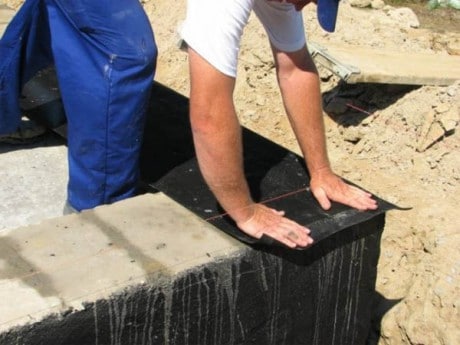
Waterproofing with roll materials is more reliable
Sprayed insulation
It is applied with a special sprayer, repeats the unevenness of the foundation. The surface to be treated is dust-free and does not need preliminary preparation... The method is quick and easy, more expensive than others.
Necessarily needs to be reinforced with geotextile, thermally bonded material, which simultaneously performs protective functions. This material is quite expensive, therefore it is effective to use it on foundations that have a complex shape (it is difficult to paste over them with roofing material) or those that are laid close to other buildings (in the absence of free access).
In addition to the options already listed, you can perform waterproofing with cement mortar or penetrating materials (mixtures of quartz sand, cement and active additives). This expensive method can protect the foundation from both moisture and certain chemical compounds.
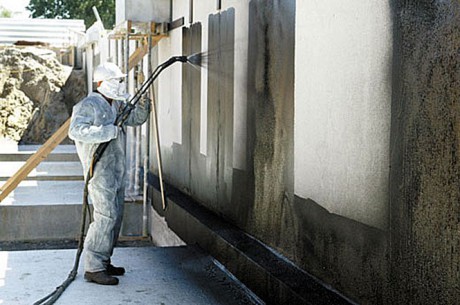
Sprayed waterproofing is a high-quality, convenient, but quite expensive method
Pile and column foundations
Spend waterproofing works it is extremely difficult with poles and piles. The process takes a long time and requires a lot of effort, and it is practically impossible to process piles. Therefore, as a material for piles and pillars, it is recommended to use moisture-resistant concrete, ranging from grade W4 and above, or concrete from W6 and above, when the groundwater is aggressive.
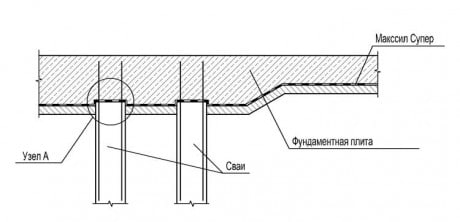
Waterproofing slab-pile foundation from below
The foundation made of wooden piles must be treated with an anti-corrosion solution. But it should be borne in mind that the wooden foundation does not tolerate drainage and other measures that lower the level of groundwater. The fact is that wooden piles do not rot only if they are completely in water. If this does not happen, their service may decrease.
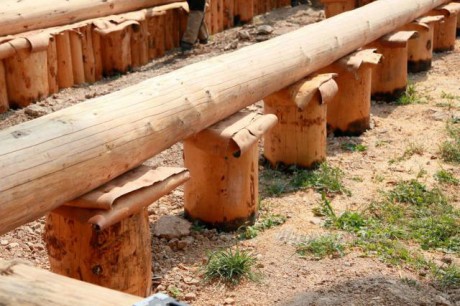
Wooden foundation for felling
How to waterproof a foundation in a pit with 90 ° walls
There are cases of erection of foundations close to the walls of the pit, usually under cramped conditions, which may become the only possible construction option. For waterproofing such a foundation, pressure walls are erected close to the walls of the pit. Waterproofing material is nailed directly onto the pressure walls. In the pit, at a distance equal to the width of the future foundation, a formwork is installed into which the foundation is poured. A pressure wall with an attached waterproofing barrier is called a “lost formwork” because it remains in the ground rather than being removed.
If such a foundation is erected from blocks, then they are laid next to the pressure wall, and the distance between them is filled with mortar.
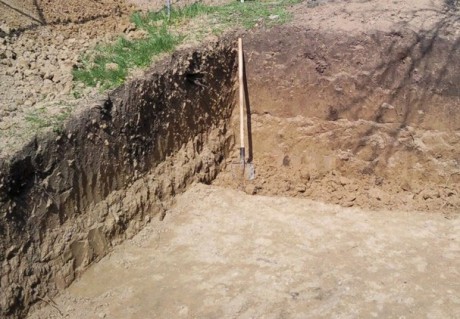
Pit with walls 90 ° for foundation
Protection of walls from moisture
Waterproofing to protect against capillary rise of moisture is laid on a base, which rises 15-50 cm above the ground. The surface is pre-dried and leveled, after which it is covered with bitumen mastic. Roofing material is laid on the mastic in 2 layers. This technology is called continuous spacer because it completely crosses the thickness of the walls and plaster.
The plinth must also be waterproofed from the outside to the level of the gasket. Moisture can come both from the snow cover and from the rain, the drops of which, fighting off the blind area, soak the wall just at the distance of the base. Therefore, for its lining, it is necessary to use waterproof materials such as water-repellent tiles.

Protection of walls from moisture capillary rise
Basement waterproofing
These works are no less important than waterproofing the foundation itself. Homes with basements need a waterproof blind area that will reduce the flow of surface water. The basement floor is waterproofed against concrete. For this, roll bitumen materials laid in 2 layers are best suited. Basement walls should be treated in the same way as strip foundations.
Bentonite mats are very suitable for waterproofing basements. It is a compact modern analogue of a clay castle. The mats are bentonite enclosed in a textile material. Differs in easy assembly and replaces a clay meter.
With pressurized groundwater, drainage must be done along the entire perimeter of the floor.
Important ! The drainage begins to work only from the moment water is discharged from the drainage material, for example, into the storm sewer. Until this happens, water can stand in the pit, even with laid drainage materials.
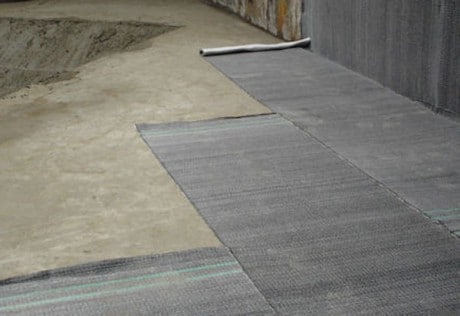
Layout of bentonite mats
The waterproofing of the basement and basement should be approached very carefully. This type of work is very difficult to fix after the first leaks appear. For repairs, you will have to re-open the pit. By this time, the blind area may no longer be, and the adjacent territory is inhabited. Therefore, the technology must be followed in every detail.
In cases where leaks nevertheless appear, it is necessary to re-open the pit and partially or completely replace the damaged waterproofing. Then, when this option is not possible, you will have to perform waterproofing from the inside of the basement. However, this will not keep the walls from getting wet, although they may look dry from the inside.
What materials cannot be used for waterproofing the foundation
The foundation waterproofing device cannot be performed with under-roofing films and membranes. These materials are lightweight and designed for sagging installation. Neither film nor membranes can withstand surface friction that occurs during seasonal ground movements. Moreover, they are not designed for protection from groundwater.

The foundation must be protected and the most important protection is reliable waterproofing
It is also impractical from the point of view of economy to use materials with UV stabilization, such as a stabilized PVC membrane. UV resistance is evaluated additionally, but underground this function will simply not be used.



